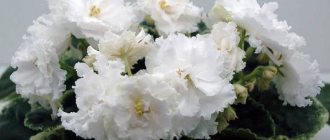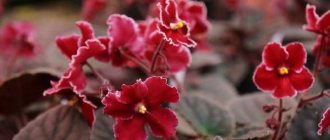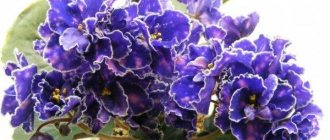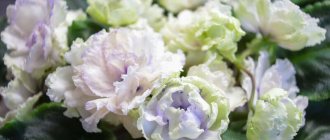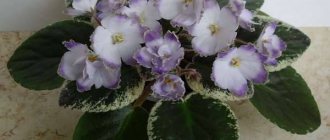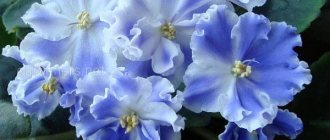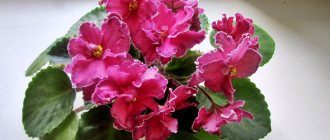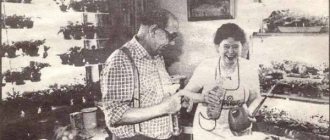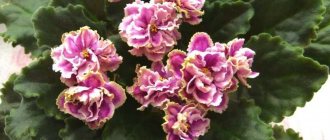I am the keeper of B.M. violet varieties. and T.N. Makuni.
I started collecting a collection of varieties of their selection a year and a half ago. Since the collection period is short and they are mainly grown from cuttings, the plants in the collection are in different forms - some are already blooming, and some are still children and even cuttings.
It is believed that Makuni created more than 400 varieties, but the author's catalog does not exist. Find out about the varieties B.M. And T.N. Makuni can be found, for example, on this website: https://senpolii-odessa.ucoz.ua/forum/62-….
Today my collection contains 133 Makuni varieties. Therefore, I turn to the help of collectors - please share those varieties that I don’t have!
I can buy, I can exchange for the varieties I have. All year round - meeting in Moscow, in the summer - additionally by Russian Post.
A small gallery of Makuni varieties
Makuni Boris Mikhailovich and Tatyana Nikolaevna
In the domestic selection of Saintpaulias, a special place is occupied by Boris Mikhailovich (pictured) and Tatyana Nikolaevna Makuni. Their passion for Saintpaulias began with the fact that every time they passed the window of a neighboring house, they admired a real greenhouse on the windowsill. Lemons, anthuriums, Saintpaulias and other equally amazing plants grew there.
Tatyana Nikolaevna, who was fond of growing indoor flowers, looked at this miracle for a long time.
One day, wanting to please his wife, Boris Mikhailovich gave her a blue flower with the unusual name “Uzambara violet” for the holiday. After some time, the neighbor gave me the same violet, only white. Tatyana Nikolaevna had a thought: what if we combine the beauty of both violets? She crossed these two Saintpaulias, and the first experiment was successful. Boris Mikhailovich became interested and, supporting his wife’s initiative, actively became involved in the work.
In a short period of time, by historical standards, Saintpaulia turned from a modest Cinderella into the queen of indoor plants, displacing ficuses, geraniums, cacti... The role of wizards was taken on by breeders - from the inconspicuous blue violet, varieties with red and yellowish flowers were obtained, chimera violets with a contrasting stripe center of the petal, fringed violets, double violets, varieties with “fantasy” coloring - with specks and dots of contrasting color, mini violets, trailers, variegated leaves, i.e. plants with variegated leaves, and not only green and white, but also green with pink or lemon. The variegated leaves are so spectacular that they sometimes overshadow the flowers. Original forms of flowers also appeared, one of which is called “wasp”. The Makuni began breeding in 1962 practically from scratch. At that time, obtaining a pink or white violet was already considered an achievement; large and fantastically colored flowers were a great rarity and absolutely supernatural - a thousandth collection of Saintpaulias in a Moscow apartment.
New varieties began to appear, bred by Boris Mikhailovich and Tatyana Nikolaevna Makuni, for example “Natalie” - the first fringed terry variety. It was followed in large numbers by other magnificent hybrids, often looking like works of art. A masterpiece of the 1970s. recognized as “Favorite” - large, asymmetrically shaped, two-colored stars: lilac, turning into rich purple.
The “finest hour” for the Makuni couple was the 1980s. At this time, many violet lovers worked fruitfully, but the palm rightfully belonged to Makuni. V.A. Mikheev in his book “Saintpaulia” emphasizes that many years of selection work, combined with a scrupulous system of recording results, allowed them to both identify certain promising crossing lines and learn to avoid hybridization “dead ends.” Makunin's Saintpaulias even then impressed even the Japanese, who had a high culture of floriculture - in the Land of the Rising Sun, Russian violets were shown at specially organized exhibitions. Until the mid-1990s. Makuni bred about 300 varieties of Uzambara violets, including snow-white “Galina Ulanova”, watercolor blue “Aprilka”, and pink terry “Sorceress”. The “Winter Smiles” variety looks like a fairy tale: white double and semi-double flowers with a pink “blush”, on the edges of the petals there are crimson strokes and an elegant, light green fringe reminiscent of frost; the core of the flower, as if protecting its secret, is covered by the inner petals; leaves are green, with an olive tint, rounded, slightly elongated. It is difficult to calculate how many awards at exhibitions this beautiful violet has won and continues to win. And today it is one of the best and most popular varieties of domestic selection. Makuni’s masterpieces in the last third of the last century were “Sweet Lips” and “Alice”.
In 1995, as a token of gratitude for the sent leaf cuttings and peduncles of fancy violets (chimeras), several Russian cultivars were sent to the American Saintpaulia Society (AVSA, exists since 1946), including leaf cuttings of varieties bred by B.M. Makuni “Spring Melody”, “Beloved Mother-in-Law”... They created a real sensation at the AVSA exhibition in Seattle. Next to one of Makunin’s violets there was a sign “Russian superstar”. In the creative union of the Makuni spouses, Boris Mikhailovich, a physics engineer by training, was the leader. He is a generator of ideas, and Tatyana Nikolaevna was engaged in sowing, picking, and growing seedlings. Without exaggeration, we can say that the varieties of violets bred by B.M. and T.N. Makuni, opened a new page in Saint-Paul growing, and today not a single exhibition can be imagined without their varieties, be it “Winter Smiles”, “Solveig’s Song” or “Tatiana’s Day”... Our compatriot, famous biologist, plant breeder, academician Pyotr Petrovich Vavilov ( 1918–1984) said: “Selection is evolution directed by the will of man.” And it’s hard to disagree with this. It is very difficult to create a new variety, but it is also not easy to come up with a name for it without repeating it. Most of Makunin’s titles are interesting and memorable, for example, “In Memory of Academician Vavilov”, “Galina Ulanova”, “Garnet Bracelet”, “Running on the Waves”, “Mistress of the Copper Mountain”, “Sea Soul”, “Solveig’s Song”, “Merry Potassium permanganate” ", "Leopold the Cat", "Magic Snow", "Ah, Nastasya", "Festive Fireworks", "Evening Chime", "Spring Drops".
And only the name of one of the latest varieties of B.M. Makuni, “In Memory of Tanya Makuni”, sounds like a broken string, evoking a feeling of sorrow... The collector of violets Anna Skvortsova dedicated her poem “Vologda Lace” (In Memory of Tanya Makuni) to this wonderful woman and this amazing variety:
Slender figure, long eyelashes... Tanya the lacemaker is knitting something again. The ligature of patterns curls on a white napkin, Like on the best dress of the Snow Queen!
Topics of printed works by T.N. and B.M. The Makuni were very different: descriptions of new varieties, propagation by seeds and leaf cuttings, winter maintenance of plants and replanting, watering, fertilization, pest control... When there was clearly not enough literature about violets, their book “Saintpaulia” was almost the only guide for beginners collectors. This publication remains the most authoritative to this day.
Talent B.M. Makuni sparkled with many facets. Boris Mikhailovich drew beautifully: he illustrated his books, painted pictures, and wrote poetry. He took great photographs. And even today, when photographic technology has come a long way, his slides remain unsurpassed. He knew many “violet” stories and told them with his characteristic sense of humor. His distinguishing feature was generosity: he loved to give gifts.
Some people love stamps, some cats, some dogs. He loved to give violets for the holiday and just like that...
To this day, Makuni’s friends and colleagues remember the tradition of giving a carpet of violets on New Year’s Eve. The spectacle was extraordinary: picked flowers of various colors were placed in a wide flat vessel on the water, and for many days they delighted with their bright combination of colors and exquisite shapes. And at that time it was snowing outside the window...
The Makuni couple believed that violets are like people, and each flower, like each person, is individual and has its own character. They were convinced that you need to talk to the plant, encourage it, and it will respond to the attention with generous flowering. They firmly believed that the plant understood everything. And as if to confirm this, the incredible happened: on the 40th day after the death of Boris Mikhailovich, huge, amazingly beautiful red flowers opened on a shelf with seedlings of his last selection! It was like a farewell fireworks display...
At the September 2005 exhibition dedicated to the 75th anniversary of B.M. Makuni, V.N. Kalgin, the organizer of the “Violet House,” announced the establishment of the B.M. Prize. Makuni, which will be awarded once a year to the authors of the best new products of Russian selection and to collectors.
Source of the article: https://bio.1september.ru/article.php?ID=…
Photo by B.M. Makuni taken from the sites: Senpolia.tskm.ru and Ssr.su
If you have any additions or clarifications, please leave your comments. If you have photos of the varieties of violets mentioned in the article, post them so we can admire them. (Unfortunately, I don’t have anything to brag about yet.)
If you just have favorite Makuni varieties, you can also present them to our attention.
Popular varieties with photos
Many varieties of the Makuni selection have become popular among violet lovers , but many connoisseurs consider the “Winter Smiles” variety to be the calling card of the couple. This Saintpaulia has white double flowers with a pinkish tint, along the edges of the petals there is a delicate fringe of light green color similar to frost. “Winter” is still considered one of the best achievements of domestic selection and continues to receive awards at exhibitions. The flower propagates well by cuttings; usually there are no problems in growing it.
Important! If some varieties of the Makuni selection have today been replaced by modern interesting options, then “Winter Smiles” remains a unique variety that has no analogues.
Several conventional series of Makuni selection can be distinguished.
- In the “pink” series you can choose one, which is distinguished by high peduncles and flowers up to 6 cm. “Pink Light” and “Pink Fireworks” make up a range of various shades of pink.
- The “dark” series includes burgundy and purple varieties, of which the most popular are “Dark Prince”, “Panther”, “Graceful Stranger” and “Leshy”.
- In the “lilac” series, “Blue Treasure”, “Solveig’s Song”, “Lilac Excitement” and “Chic Lilac” are among the best.
- In the “white” series we can highlight the most common varieties “Snow-White Irishka” (another name is “Irinka the Blonde”), “In Memory of Academician Vavilov”, “Tatyana’s Day”, “Vologda Lace”. The legendary "White-winged Gull" has snow-white stars with a bright crimson border.
Below are descriptions and photos of some popular varieties of Makuni selection (“Your Majesty” and others).
"Forest Magic"
This elegant violet has dark green leaves and double bright pink-crimson flowers. Along the edge of the petals you can see a light green or green fringe . Socket size is standard.
In the book “Saintpaulia” by B.M. Makuni and T.M. It is recommended that Klevenskaya pay special attention to “Forest Magic” when growing it from leaf cuttings. If leaves are rooting, it is recommended to do this in a greenhouse. A number of violet lovers note difficulties in forming a rosette and slow flower growth.
"Your Majesty"
Simple light green leaves are combined with luxurious pink double star. The petals of the flower have wavy edges. The rosette is large, but neat and well formed. Often this variety blooms with a wreath rather than a cap due to diverging peduncles.
“Your Majesty” is considered one of the best varieties of Makuni selection and has long become a classic. Collectors note the violet's abundant and long-lasting flowering and relatively easy care, which makes "Your Majesty" a suitable plant for beginning violet lovers.
Interestingly, in cool temperatures, a small light green border is visible along the edges of the flowers. The disadvantage of the variety can be considered weak peduncles, which cannot always withstand a lush large mass of flowers.
"Yoke"
“Coquette” has a rosette of bright green leaves, decorated with double white and pink flowers with a light green frill. Large flowers are collected in clusters. In appearance, “Coquette” is similar to “Your Majesty”, but has a more compact rosette.
“Coquette” blooms profusely and for a long time. The flowers open slowly but last up to 6 weeks. The plant tolerates temperature changes calmly , but reacts negatively to too much watering.
"Jupiter"
This variety may also be called "Lord". The dark green rosette is topped with large double pink flowers with fringed edges. "Jupiter" flowers can grow up to 8 centimeters.
"Jupiter" is quite capricious in cultivation, so it is an infrequent guest in collections. When growing a plant, increased attention to thermal, air and water conditions is required. After selecting optimal conditions, it is advisable to maintain them constantly, because The pink giant does not like changes in temperature or humidity.
Want to learn more about other types of violets? Read our articles:
- violet varieties YAN;
- Optimara;
- Chanson;
- Saintpaulia by breeder K. Morev;
- pansies;
- Fairy;
- Frosty Cherry and Winter Cherry;
- Isadora;
- Blue fog.

